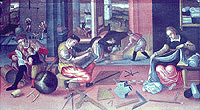
The Measurers:
a Flemish Image of Mathematics in the Sixteenth Century
List of Figures
Introduction: figures 1 to 3
The Mathematicians: figures 4 to 15
The Measurers: figures 16 to 31
The Collectors: figures 32 to 48
The Measurers
Figures: 16 17 18 19 20
21 22 23 24 25 26 27 28 29 30 31 32
 Figure 16
Figure 16
Drawing, Les Mesures
Attributed to the school of Frans Floris.
By kind permission of the Ecole nationale supÚrieure des Beaux-Arts, Paris.
 Figure 17
Figure 17
Geographical Globe
From Peter Apian and Gemma Frisius, Cosmographia, sive descriptio universi orbis (Antwerp, 1584)
(catalogue no. 2).
Note the quadrant, the pillar sundial, and tiny dipych sundial indicating the meridian.
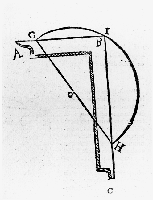 Figure 18
Figure 18
The square used to illustrate one of the properties of a semicircle.
From Adriaan Metius, ArithmeticŠ et geometriŠ practica (1611).
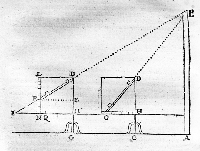 Figure 19
Figure 19
The use of the geometrical quadrant.
From Adriaan Metius, ArithmeticŠ libri duo: et geometriŠ libri VI (Leiden, 1640).
The linear division of the sides of the square means that the angles required are taken as ratios instead of in degrees; this allows the convenient conversion of, for example, lengths measured on the ground to inaccessible heights.
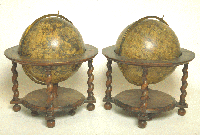 Figure 20
Figure 20
Pair of Blaeu globes.
See catalogue no. 15
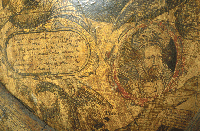 Figure 21
Figure 21
Detail from the celestial globe showing a portrait of Tycho Brahe.
See catalogue no. 15
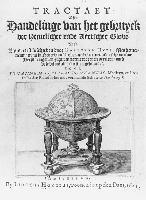 Figure 22
Figure 22
Title-page of the Dutch edition of Hues's account of the globes, illustrating a celestial globe by Hondius.
See catalogue no. 22
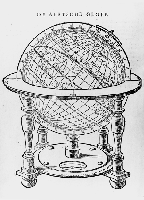 Figure 23
Figure 23
The terrestrial globe in the Hondius edition of Hues's work.
See catalogue no. 22
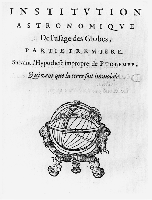 Figure 24
Figure 24
Introductory page to the first section of Blaeu's book, 'following the improper hypothesis of Ptolemy, which holds that the earth is stationary'.
See catalogue no. 23
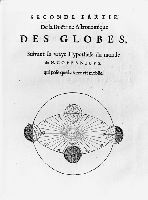 Figure 25
Figure 25
Introductory page to the second section of Blaeu's book, 'according to the true hypothesis of the world of N. Copernicus, which proposes the motion of the earth'.
See catalogue no. 23
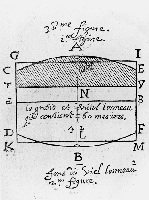 Figure 26
Figure 26
An illustration of the use of Coignet's sector.
Coignet's sector is described in the manuscript illustrated in figure 7 and figure 8 and is used to perform calculations relating to volumes of wine in barrels.
Michel Connette [Coignet], La gÚometrie (Paris, 1626).
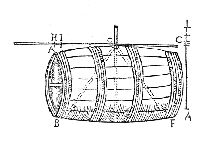 Figure 27
Figure 27
Gauging a barrel.
From Adriaan Metius, ArithmeticŠ libri duo: et geometriŠ libri VI (Leiden, 1640).
The same woodcut appears in his ArithmeticŠ et geometriŠ practica (1611).
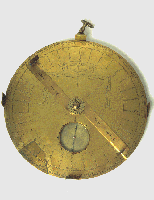 Figure 28
Figure 28
Holland circle
See catalogue no. 32
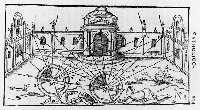 Figure 29
Figure 29
The use of the shadow square or geometrical quadrant on an astrolabe, simple theodolite or Holland circle.
The shadow square is used to take bearings from either end of a measured baseline MN, and then to transfer these measurements on to a plan drawn to scale (see figure 30).
Gemma Frisius, De astrolabo catholico (Antwerp, 1556)
(catalogue no. 3).
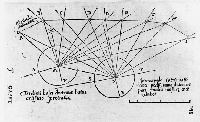 Figure 30
Figure 30
The use of the shadow square or geometrical quadrant on an astrolabe, simple theodolite or Holland circle.
Bearings taken with the shadow square (see figure 29) after transfer on to a plan drawn to scale.
Gemma Frisius, De astrolabo catholico (Antwerp, 1556)
(catalogue no. 3).
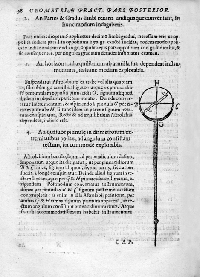 Figure 31
Figure 31
A simple theodolite on a staff.
Illustrated in Adriaan Metius, ArithmeticŠ et geometriŠ practica (1611).
Introduction: figures 1 to 3
The Mathematicians: figures 4 to 15
The Collectors: figures 32 to 48
Contents
(c) Museum of the History of Science, Broad Street, Oxford, England.

 Figure 16
Figure 16 Figure 17
Figure 17 Figure 18
Figure 18 Figure 19
Figure 19 Figure 20
Figure 20 Figure 21
Figure 21 Figure 22
Figure 22 Figure 23
Figure 23 Figure 24
Figure 24 Figure 25
Figure 25 Figure 26
Figure 26 Figure 27
Figure 27 Figure 28
Figure 28 Figure 29
Figure 29 Figure 30
Figure 30 Figure 31
Figure 31